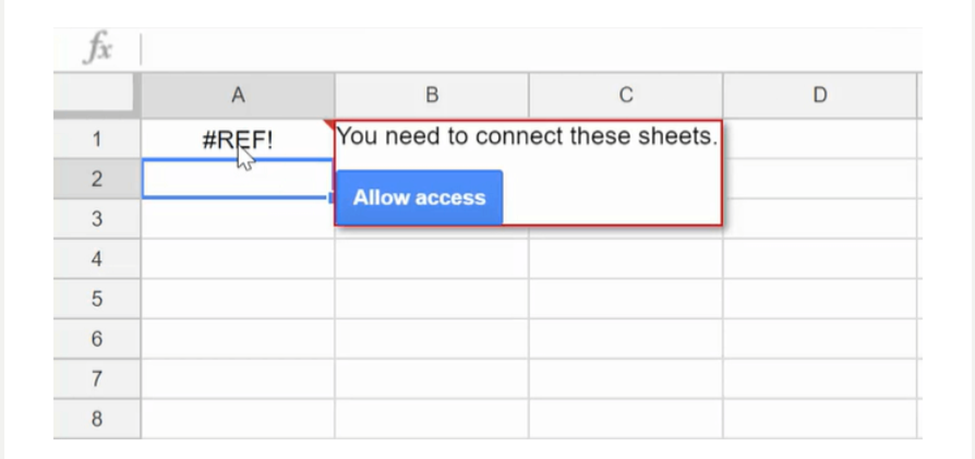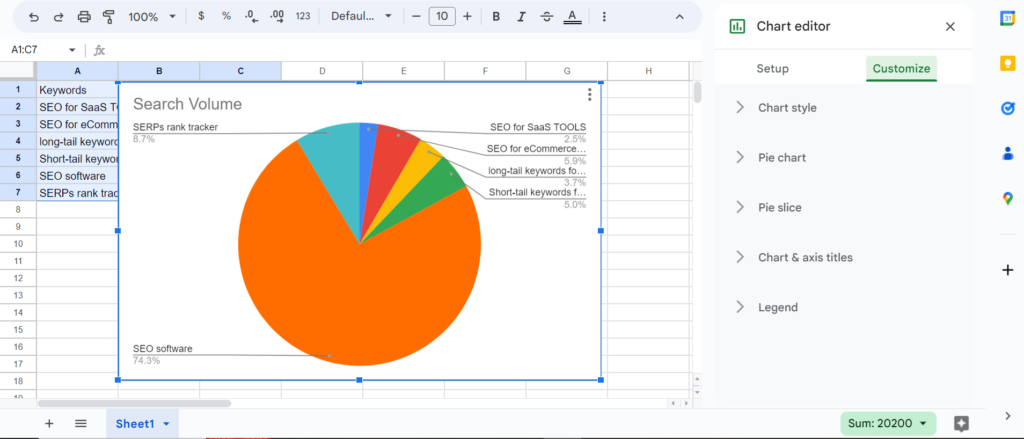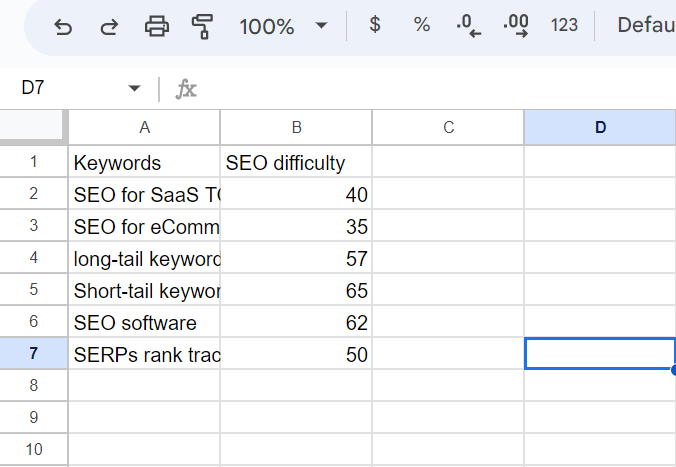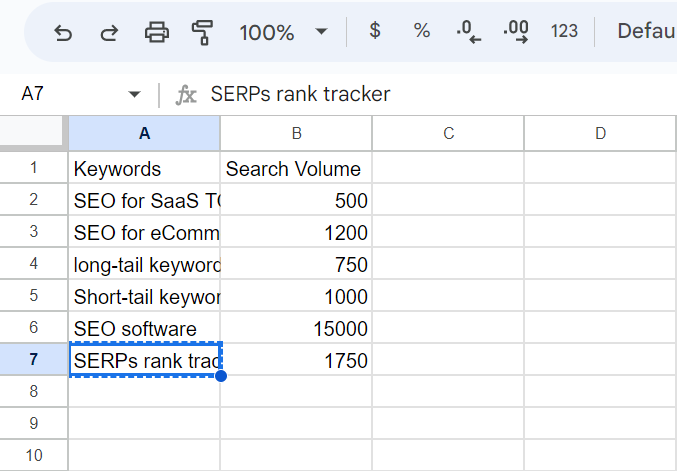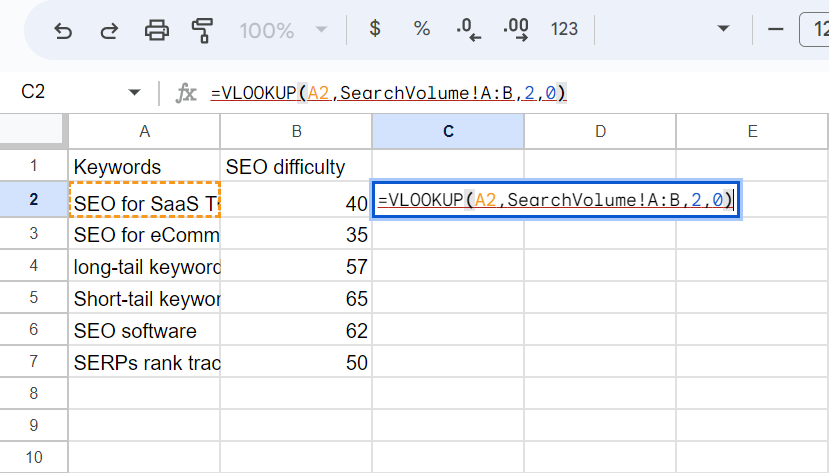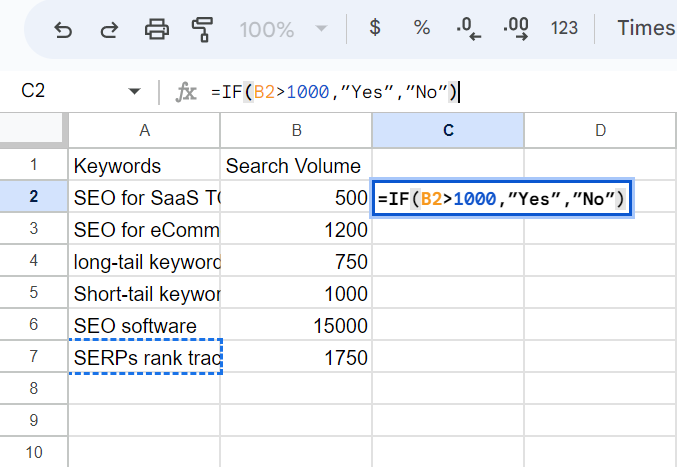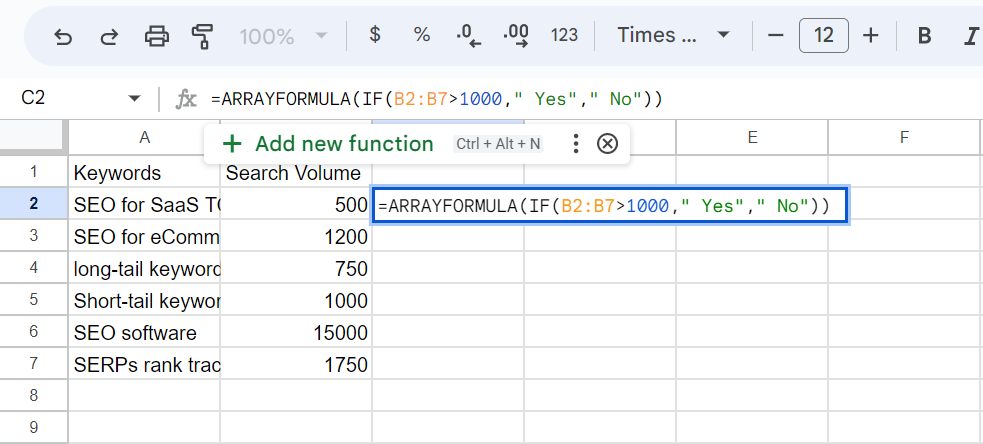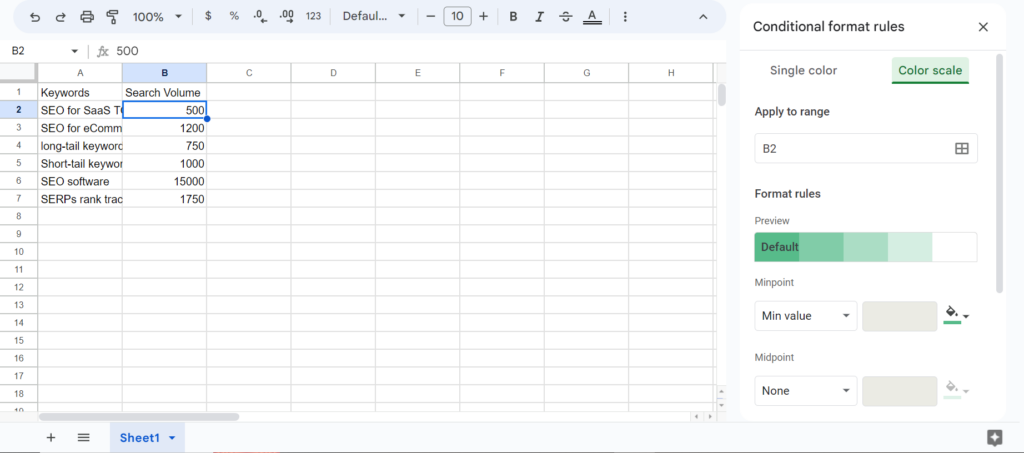As the world increasingly digitizes, businesses constantly seek ways to improve their online presence. A crucial strategy to achieve this purpose is via search engine optimization (SEO).
However, SEO can be complex and time-consuming, requiring much data to track keyword rankings, analyze competitors, and more. That’s where Google Sheets comes in!
This versatile spreadsheet tool helps you manipulate data using different built-in functions, add-ons, or templates. While it isn’t primarily designed for SEO, it can take off the burden of spending hours importing, integrating, splitting, merging, analyzing, or deleting data.
Most importantly, it helps streamline and automate many aspects of SEO.
So, get your notepad out as we explore how to use Google Sheets for SEO, from basic features to more advanced techniques.
Basic Google Sheets Features for SEO
Before we delve into the specifics of using Google Sheets for SEO, let’s first review some of the basic features that will be useful. If you’re new to Google Sheets, it’s crucial to understand how to import data, sort and filter data, create charts and graphs, and more.
1. Creating a Spreadsheet
To create a new spreadsheet, log into your Google account and proceed to the Sheets homepage. You can create a new blank spreadsheet or choose from various templates.
When creating a new spreadsheet, it’s essential to consider what data you want to track and how you want to organize it.
2. Importing Data
Importing data into Google Sheets is simple – copying and pasting data directly from a website or uploading a file. Once you have your data in the spreadsheet, you can manipulate it using the tools provided.
In addition, you can use the IMPORTRANGE function to import data from another spreadsheet to the initial sheet (in the latter part of this article, we will highlight some Google Sheet formulas that will increase your effectiveness with this tool).
The IMPORTRANGE formula =IMPORTRANGE(“spreedsheet_url”, “range_string”)
NB: The spreedsheet_url is the spreadsheet URL you want to get data from. The range_string is the range of the cells containing the data you want to import.
Here is an example of an IMPORTRANGE function – =IMPORTRANGE(“https://docs.google.com/spreadsheets/d/1Cybp8N_rxCLddcI_HOcUgxDefxV3TEOO8VGxHAa0Vfo/edit#gid=0”, “Data! B2:C22”)
The last step is to proceed to the target sheet and click Enter on your keyboard. A Reference error immediately appears as proof that the target sheet cannot accept data from the source sheet.
Move your cursor over the REF! notification and click Allow access.
3. Sorting and Filtering Data
You’ll likely want to sort and filter your data based on different criteria to make sense of it.
In Google Sheets:
# Select the cells you want to filter
# Click data at the top of the sheet.
# Click create a filter. You will see an icon at the header of the selected cells. After clicking on the icon, you will have options on how to filter your data – “Sort A-Z,” “Sort Z-A,” “filter by condition,” “filter by values,” and more.
You can also use the “Filter” tool to hide rows that don’t meet specific criteria.
4. Creating Charts and Graphs
Charts and graphs are a practical way to visualize your data and make it easier to understand.
You can create a chart in Google Sheets by highlighting the data you want to include and clicking the “Insert Chart” button.
You can choose from various chart types, such as bar charts, line charts, or pie charts.
5. Google Sheets Keyboard Shortcuts
Keyboard shortcuts are easy ways to bypass a lot of processes. These shortcuts help users use Google Sheet formulas better and navigate their sheets in a twinkle of an eye.
Check out the standard Google Sheets keyboard shortcuts to better navigate, format, and use your data.
Advanced Google Sheets Features for SEO
Google Sheets is a powerful tool for various purposes, including Search Engine Optimization (SEO) tasks. Users can leverage several advanced features to maximize the potential of Google Sheets for SEO. Here are some of them:
1. Using formulas to automate data entry and calculations
One of the most valuable features of Google Sheets is the ability to use formulas to automate data entry and perform calculations.
This practice can save time and effort, especially when dealing with large data. For example, you can use formulas to automatically pull data from other sheets or even perform complex SEO analysis.
Let’s examine a few Google Sheet formulas every SEO expert should know:
# VLOOKUP
This formula, which stands for Vertical LOOKUP, is used for importing data from one spreadsheet into another spreadsheet as long as they share common values.
For example, if we have two spreadsheets containing the same list of keywords. However, one includes the SEO difficulties of the keywords, while the other contains the search volumes of the keywords.
Note: Both spreadsheets contain the same list of keywords in the same column.
If we want to import the SEO volumes of the keywords in the second spreadsheet into the first spreadsheet using the VLOOOK formula, we will use the formula – VLOOKUP(search_key,range,index,is_sorted)
Search_key is the value both spreadsheets have in common. We will start with the spreadsheet’s first keyword, A2.
Range is the field where you enter the name of the tab from which you obtain the data and the range of columns your formula should read. Columns A (Keyword) and B should be (search volume).
Index is the column number of the data you want to import. A=1, B=2
Is_sorted is set as zero or false to import the exact match. TRUE means not an exact match, while FALSE means exact matches only.
To enter the formula, we will click the C2 of the first spreadsheet and enter the formula =VLOOKUP(A2,SearchVolume!A:B,2,0) and press Enter.
You can drag from the first cell (C2) down the column, and the answers will automatically fill in after you enter the formula for the first keyword and press Enter.
# The IF Formula
The IF formula allows you to vet whether a condition is true or false for your spreadsheet’s data list.
The formula is =IF(condition,value_if_true, value_if_false)
Condition is what we are testing to be true or false.
If the condition is true for a specific data, value_if_true will be displayed and vice versa.
For example, to check if the search volumes of our keywords are greater than 1000, we input the formula:
=IF(B2>1000,”Yes”,”No”) in the C2 cell.
Once you enter the formula, you can drag from the first cell C2 down the column and the answers autofill.
All the keywords with search volumes over 1,000 per month show up as “YES,” and those with traffic under 1,000 show up as “NO.”
You can also use other signs alongside the formula, such as Equal to (=), Not equal (<>), Greater than (>), Less than (<), Greater than or equal to (>=), or Less than or equal to (<=).
Bonus
You can use the ARRAYFORMULA to auto-populate answers for an entire row or column. All you need to do is include the first and last cells in the formula.
For example, we want to perform an IF function to get keywords with search volumes greater than 1000.
We input the formula =ARRAYFORMULA(IF(B2:B7>1000,” Yes”,” No”)) in the C2 cell.
We click Enter, and we have the answers in the column automatically.
# The SEARCH Formula
The formula helps you check a list of data for a specific value.
For example, if you copy the list of your pages indexed on Google into a spreadsheet and want to identify blog articles.
Instead of manually searching for your blog articles’ URLs, you can use the formula =SEARCH(search_query, text_to_search)
You will need to combine this formula with the IF formula. So you have =IF(SEARCH(“/blog/”,A2),”Blog”,””)
This formula will pull out URLs featuring /blog/ starting from cell A2 and flag others as ERROR.
We’ve got a lot more to cover in this article. Click the video below to learn other relevant Google Sheet formulas to improve your SEO game.
2. Creating pivot tables for deeper analysis
Pivot tables are a powerful tool that allows you to analyze large amounts of data quickly and easily. When looking at raw data, they can help identify patterns, trends, and correlations that might take time to be noticeable.
Using pivot tables in Google Sheets, you can drill down into your data and gain insights that inform your SEO strategy.
A pivot table allows you to take an absurdly loud dataset and organize it according to your output needs.
3. Using add-ons to extend the functionality
Google Sheets offers a range of add-ons that can extend its functionality and make it even more helpful for SEO tasks.
For example, you can use an add-on like SEOTools for Google Sheets to analyze your website’s performance and identify areas for improvement.
You can also use an add-on like Supermetrics to pull data from other sources, such as Google Search Console, Google Analytics or SEMrush, and integrate it with your Google Sheets.
4. Collaborating with team members
Google Sheets is a cloud-based tool allowing easy collaboration. You can share your sheets with others, set permissions to control access and work on them in real time. This makes it easier to coordinate SEO efforts and ensure everyone is on the same page.
“Utilizing checkboxes (from the Insert menu) and Filter Views (Data > Filter Views) on Google Sheets, our SEO team can effectively work in tandem. Insert a column of checkboxes to indicate if an entry is already being worked on. If you have an additional column of team member names, a Filter View allows individuals to filter the table by their name only without changing the list order or visibility for anyone else. For a more engaging user experience, you can also set up conditional formatting to cross out or black out a row once the checkbox equals TRUE.” Midori Chen, SEO Coordinator at Resume Genius.
Specific Ways to Use Google Sheets for SEO
Google Sheets can be a valuable tool for SEO professionals and website owners looking to track and analyze their website’s performance. Here are some specific ways to use Google Sheets for SEO:
1. Keyword Research
A crucial aspect of SEO is keyword research. This involves finding the right keywords and phrases people are searching for and optimizing your website and content accordingly. Google Sheets can be an excellent tool for this process.
To get started, you can use Google’s Keyword Planner to find relevant keywords for your website. You can then export the data into a CSV file and import it into Google Sheets. This will allow you to organize and analyze the data more efficiently.
2. Tracking keyword rankings
Use Google Sheets to create a spreadsheet to track the performance of specific keywords over time. Include columns for the keyword, the search engine, the current ranking position, and the date. This will help you monitor your progress in search engine rankings and identify areas where you need to improve your SEO efforts.
Head to Google Search Console, click on Performance, then Date, then Compare. You’ll get a table which you can export into a Google Sheet.
Most importantly, Keyword.com rank tracker API makes the job easy. This rank tracker API helps you track keyword position and takes off the burden of spending hours downloading and importing your SERP history. You can pull unlimited data from your site as a CSV file with the API and feed it into your own Google Sheet to drive decisions and dazzle your clients.
Other tools limit your API calls, but keyword.com API allows you to track keyword rankings without a monthly limit or upgrade. Start a 14-day free trial to start rank tracking.
After importing your data into the spreadsheet, proceed with a conditional formatting operation. This effect is found under Format > Conditional Formatting > Color Scale
Conditional formatting lets you format cells so that their appearance changes dynamically according to the value they contain or to values in other cells. Moreso, it makes your metrics visible at a glance.
3. Analyzing backlinks
Create a spreadsheet to track the backlinks to your website. Include columns for the URL of the linking page, the anchor text, the domain authority of the linking site, and the date the website acquired the link. This will help you identify high-quality backlinks that are driving traffic to your site and identify opportunities for new backlinks.
4. Monitoring website traffic
“One of the most interesting ways I use Google Sheets in my SEO campaigns is to compare historical traffic against Google Trends data. With this, I can identify if traffic was down due to seasonality, brand awareness, or something else.” David Zimmerman, Internet Marketing Consultant at Reliable Acorn.
Use Google Sheets to track your website’s traffic over time. Include columns for the date, the number of visitors, the bounce rate, and the traffic sources. This will help you identify trends in your website traffic and understand where your visitors are coming from.
5. Creating and tracking content calendars
Use Google Sheets to create a content calendar to plan and track your marketing efforts. Include columns for the date, the content type, the topic, the keywords, and the status of the content (such as “draft,” “published,” or “promoted”). This strategy will ensure your content marketing efforts align with your overall SEO strategy.
6. Content Planning
Creating high-quality content is an effective way to improve your SEO. But it can be challenging to develop new ideas for content regularly.
Google Sheets can be a helpful tool for planning your content strategy. You can use it to brainstorm new ideas for content, organize your content calendar, and keep track of the progress of different pieces of content.
Keeping this information in one place ensures your content strategy is organized and effective.
Conclusion
When properly used, Google Sheets can improve your SEO strategy and help you find, compare, review, analyze, extract, or integrate SEO data more strategically and effectively.
Get right in and see what is possible! Alternatively, track your data in Keyword.com and export it into a sheet so that you can customize it according to your needs. Start your free, 14-day trial.
Want to become a Keyword Master? Have a look at our Keyword Monitoring Guides and our Keyword Academy.
As the world increasingly digitizes, businesses constantly seek ways to improve their online presence. A crucial strategy to achieve this purpose is via search engine optimization (SEO).
However, SEO can be complex and time-consuming, requiring much data to track keyword rankings, analyze competitors, and more. That’s where Google Sheets comes in!
This versatile spreadsheet tool helps you manipulate data using different built-in functions, add-ons, or templates. While it isn’t primarily designed for SEO, it can take off the burden of spending hours importing, integrating, splitting, merging, analyzing, or deleting data.
Most importantly, it helps streamline and automate many aspects of SEO.
So, get your notepad out as we explore how to use Google Sheets for SEO, from basic features to more advanced techniques.
Basic Google Sheets Features for SEO
Before we delve into the specifics of using Google Sheets for SEO, let’s first review some of the basic features that will be useful. If you’re new to Google Sheets, it’s crucial to understand how to import data, sort and filter data, create charts and graphs, and more.
1. Creating a Spreadsheet
To create a new spreadsheet, log into your Google account and proceed to the Sheets homepage. You can create a new blank spreadsheet or choose from various templates.
When creating a new spreadsheet, it’s essential to consider what data you want to track and how you want to organize it.
2. Importing Data
Importing data into Google Sheets is simple – copying and pasting data directly from a website or uploading a file. Once you have your data in the spreadsheet, you can manipulate it using the tools provided.
In addition, you can use the IMPORTRANGE function to import data from another spreadsheet to the initial sheet (in the latter part of this article, we will highlight some Google Sheet formulas that will increase your effectiveness with this tool).
The IMPORTRANGE formula =IMPORTRANGE(“spreedsheet_url”, “range_string”)
NB: The spreedsheet_url is the spreadsheet URL you want to get data from. The range_string is the range of the cells containing the data you want to import.
Here is an example of an IMPORTRANGE function – =IMPORTRANGE(“https://docs.google.com/spreadsheets/d/1Cybp8N_rxCLddcI_HOcUgxDefxV3TEOO8VGxHAa0Vfo/edit#gid=0”, “Data! B2:C22”)
The last step is to proceed to the target sheet and click Enter on your keyboard. A Reference error immediately appears as proof that the target sheet cannot accept data from the source sheet.
Move your cursor over the REF! notification and click Allow access.
3. Sorting and Filtering Data
You’ll likely want to sort and filter your data based on different criteria to make sense of it.
In Google Sheets:
# Select the cells you want to filter
# Click data at the top of the sheet.
# Click create a filter. You will see an icon at the header of the selected cells. After clicking on the icon, you will have options on how to filter your data – “Sort A-Z,” “Sort Z-A,” “filter by condition,” “filter by values,” and more.
You can also use the “Filter” tool to hide rows that don’t meet specific criteria.
4. Creating Charts and Graphs
Charts and graphs are a practical way to visualize your data and make it easier to understand.
You can create a chart in Google Sheets by highlighting the data you want to include and clicking the “Insert Chart” button.
You can choose from various chart types, such as bar charts, line charts, or pie charts.
5. Google Sheets Keyboard Shortcuts
Keyboard shortcuts are easy ways to bypass a lot of processes. These shortcuts help users use Google Sheet formulas better and navigate their sheets in a twinkle of an eye.
Check out the standard Google Sheets keyboard shortcuts to better navigate, format, and use your data.
Advanced Google Sheets Features for SEO
Google Sheets is a powerful tool for various purposes, including Search Engine Optimization (SEO) tasks. Users can leverage several advanced features to maximize the potential of Google Sheets for SEO. Here are some of them:
1. Using formulas to automate data entry and calculations
One of the most valuable features of Google Sheets is the ability to use formulas to automate data entry and perform calculations.
This practice can save time and effort, especially when dealing with large data. For example, you can use formulas to automatically pull data from other sheets or even perform complex SEO analysis.
Let’s examine a few Google Sheet formulas every SEO expert should know:
# VLOOKUP
This formula, which stands for Vertical LOOKUP, is used for importing data from one spreadsheet into another spreadsheet as long as they share common values.
For example, if we have two spreadsheets containing the same list of keywords. However, one includes the SEO difficulties of the keywords, while the other contains the search volumes of the keywords.
Note: Both spreadsheets contain the same list of keywords in the same column.
If we want to import the SEO volumes of the keywords in the second spreadsheet into the first spreadsheet using the VLOOOK formula, we will use the formula – VLOOKUP(search_key,range,index,is_sorted)
Search_key is the value both spreadsheets have in common. We will start with the spreadsheet’s first keyword, A2.
Range is the field where you enter the name of the tab from which you obtain the data and the range of columns your formula should read. Columns A (Keyword) and B should be (search volume).
Index is the column number of the data you want to import. A=1, B=2
Is_sorted is set as zero or false to import the exact match. TRUE means not an exact match, while FALSE means exact matches only.
To enter the formula, we will click the C2 of the first spreadsheet and enter the formula =VLOOKUP(A2,SearchVolume!A:B,2,0) and press Enter.
You can drag from the first cell (C2) down the column, and the answers will automatically fill in after you enter the formula for the first keyword and press Enter.
# The IF Formula
The IF formula allows you to vet whether a condition is true or false for your spreadsheet’s data list.
The formula is =IF(condition,value_if_true, value_if_false)
Condition is what we are testing to be true or false.
If the condition is true for a specific data, value_if_true will be displayed and vice versa.
For example, to check if the search volumes of our keywords are greater than 1000, we input the formula:
=IF(B2>1000,”Yes”,”No”) in the C2 cell.
Once you enter the formula, you can drag from the first cell C2 down the column and the answers autofill.
All the keywords with search volumes over 1,000 per month show up as “YES,” and those with traffic under 1,000 show up as “NO.”
You can also use other signs alongside the formula, such as Equal to (=), Not equal (<>), Greater than (>), Less than (<), Greater than or equal to (>=), or Less than or equal to (<=).
Bonus
You can use the ARRAYFORMULA to auto-populate answers for an entire row or column. All you need to do is include the first and last cells in the formula.
For example, we want to perform an IF function to get keywords with search volumes greater than 1000.
We input the formula =ARRAYFORMULA(IF(B2:B7>1000,” Yes”,” No”)) in the C2 cell.
We click Enter, and we have the answers in the column automatically.
# The SEARCH Formula
The formula helps you check a list of data for a specific value.
For example, if you copy the list of your pages indexed on Google into a spreadsheet and want to identify blog articles.
Instead of manually searching for your blog articles’ URLs, you can use the formula =SEARCH(search_query, text_to_search)
You will need to combine this formula with the IF formula. So you have =IF(SEARCH(“/blog/”,A2),”Blog”,””)
This formula will pull out URLs featuring /blog/ starting from cell A2 and flag others as ERROR.
We’ve got a lot more to cover in this article. Click the video below to learn other relevant Google Sheet formulas to improve your SEO game.
2. Creating pivot tables for deeper analysis
Pivot tables are a powerful tool that allows you to analyze large amounts of data quickly and easily. When looking at raw data, they can help identify patterns, trends, and correlations that might take time to be noticeable.
Using pivot tables in Google Sheets, you can drill down into your data and gain insights that inform your SEO strategy.
A pivot table allows you to take an absurdly loud dataset and organize it according to your output needs.
3. Using add-ons to extend the functionality
Google Sheets offers a range of add-ons that can extend its functionality and make it even more helpful for SEO tasks.
For example, you can use an add-on like SEOTools for Google Sheets to analyze your website’s performance and identify areas for improvement.
You can also use an add-on like Supermetrics to pull data from other sources, such as Google Search Console, Google Analytics or SEMrush, and integrate it with your Google Sheets.
4. Collaborating with team members
Google Sheets is a cloud-based tool allowing easy collaboration. You can share your sheets with others, set permissions to control access and work on them in real time. This makes it easier to coordinate SEO efforts and ensure everyone is on the same page.
“Utilizing checkboxes (from the Insert menu) and Filter Views (Data > Filter Views) on Google Sheets, our SEO team can effectively work in tandem. Insert a column of checkboxes to indicate if an entry is already being worked on. If you have an additional column of team member names, a Filter View allows individuals to filter the table by their name only without changing the list order or visibility for anyone else. For a more engaging user experience, you can also set up conditional formatting to cross out or black out a row once the checkbox equals TRUE.” Midori Chen, SEO Coordinator at Resume Genius.
Specific Ways to Use Google Sheets for SEO
Google Sheets can be a valuable tool for SEO professionals and website owners looking to track and analyze their website’s performance. Here are some specific ways to use Google Sheets for SEO:
1. Keyword Research
A crucial aspect of SEO is keyword research. This involves finding the right keywords and phrases people are searching for and optimizing your website and content accordingly. Google Sheets can be an excellent tool for this process.
To get started, you can use Google’s Keyword Planner to find relevant keywords for your website. You can then export the data into a CSV file and import it into Google Sheets. This will allow you to organize and analyze the data more efficiently.
2. Tracking keyword rankings
Use Google Sheets to create a spreadsheet to track the performance of specific keywords over time. Include columns for the keyword, the search engine, the current ranking position, and the date. This will help you monitor your progress in search engine rankings and identify areas where you need to improve your SEO efforts.
Head to Google Search Console, click on Performance, then Date, then Compare. You’ll get a table which you can export into a Google Sheet.
Most importantly, Keyword.com rank tracker API makes the job easy. This rank tracker API helps you track keyword position and takes off the burden of spending hours downloading and importing your SERP history. You can pull unlimited data from your site as a CSV file with the API and feed it into your own Google Sheet to drive decisions and dazzle your clients.
Other tools limit your API calls, but keyword.com API allows you to track keyword rankings without a monthly limit or upgrade. Start a 14-day free trial to start rank tracking.
After importing your data into the spreadsheet, proceed with a conditional formatting operation. This effect is found under Format > Conditional Formatting > Color Scale
Conditional formatting lets you format cells so that their appearance changes dynamically according to the value they contain or to values in other cells. Moreso, it makes your metrics visible at a glance.
3. Analyzing backlinks
Create a spreadsheet to track the backlinks to your website. Include columns for the URL of the linking page, the anchor text, the domain authority of the linking site, and the date the website acquired the link. This will help you identify high-quality backlinks that are driving traffic to your site and identify opportunities for new backlinks.
4. Monitoring website traffic
“One of the most interesting ways I use Google Sheets in my SEO campaigns is to compare historical traffic against Google Trends data. With this, I can identify if traffic was down due to seasonality, brand awareness, or something else.” David Zimmerman, Internet Marketing Consultant at Reliable Acorn.
Use Google Sheets to track your website’s traffic over time. Include columns for the date, the number of visitors, the bounce rate, and the traffic sources. This will help you identify trends in your website traffic and understand where your visitors are coming from.
5. Creating and tracking content calendars
Use Google Sheets to create a content calendar to plan and track your marketing efforts. Include columns for the date, the content type, the topic, the keywords, and the status of the content (such as “draft,” “published,” or “promoted”). This strategy will ensure your content marketing efforts align with your overall SEO strategy.
6. Content Planning
Creating high-quality content is an effective way to improve your SEO. But it can be challenging to develop new ideas for content regularly.
Google Sheets can be a helpful tool for planning your content strategy. You can use it to brainstorm new ideas for content, organize your content calendar, and keep track of the progress of different pieces of content.
Keeping this information in one place ensures your content strategy is organized and effective.
Conclusion
When properly used, Google Sheets can improve your SEO strategy and help you find, compare, review, analyze, extract, or integrate SEO data more strategically and effectively.
Get right in and see what is possible! Alternatively, track your data in Keyword.com and export it into a sheet so that you can customize it according to your needs. Start your free, 14-day trial.
Want to become a Keyword Master? Have a look at our Keyword Monitoring Guides and our Keyword Academy.
As the world increasingly digitizes, businesses constantly seek ways to improve their online presence. A crucial strategy to achieve this purpose is via search engine optimization (SEO).
However, SEO can be complex and time-consuming, requiring much data to track keyword rankings, analyze competitors, and more. That’s where Google Sheets comes in!
This versatile spreadsheet tool helps you manipulate data using different built-in functions, add-ons, or templates. While it isn’t primarily designed for SEO, it can take off the burden of spending hours importing, integrating, splitting, merging, analyzing, or deleting data.
Most importantly, it helps streamline and automate many aspects of SEO.
So, get your notepad out as we explore how to use Google Sheets for SEO, from basic features to more advanced techniques.
Basic Google Sheets Features for SEO
Before we delve into the specifics of using Google Sheets for SEO, let’s first review some of the basic features that will be useful. If you’re new to Google Sheets, it’s crucial to understand how to import data, sort and filter data, create charts and graphs, and more.
1. Creating a Spreadsheet
To create a new spreadsheet, log into your Google account and proceed to the Sheets homepage. You can create a new blank spreadsheet or choose from various templates.
When creating a new spreadsheet, it’s essential to consider what data you want to track and how you want to organize it.
2. Importing Data
Importing data into Google Sheets is simple – copying and pasting data directly from a website or uploading a file. Once you have your data in the spreadsheet, you can manipulate it using the tools provided.
In addition, you can use the IMPORTRANGE function to import data from another spreadsheet to the initial sheet (in the latter part of this article, we will highlight some Google Sheet formulas that will increase your effectiveness with this tool).
The IMPORTRANGE formula =IMPORTRANGE(“spreedsheet_url”, “range_string”)
NB: The spreedsheet_url is the spreadsheet URL you want to get data from. The range_string is the range of the cells containing the data you want to import.
Here is an example of an IMPORTRANGE function – =IMPORTRANGE(“https://docs.google.com/spreadsheets/d/1Cybp8N_rxCLddcI_HOcUgxDefxV3TEOO8VGxHAa0Vfo/edit#gid=0”, “Data! B2:C22”)
The last step is to proceed to the target sheet and click Enter on your keyboard. A Reference error immediately appears as proof that the target sheet cannot accept data from the source sheet.
Move your cursor over the REF! notification and click Allow access.
3. Sorting and Filtering Data
You’ll likely want to sort and filter your data based on different criteria to make sense of it.
In Google Sheets:
# Select the cells you want to filter
# Click data at the top of the sheet.
# Click create a filter. You will see an icon at the header of the selected cells. After clicking on the icon, you will have options on how to filter your data – “Sort A-Z,” “Sort Z-A,” “filter by condition,” “filter by values,” and more.
You can also use the “Filter” tool to hide rows that don’t meet specific criteria.
4. Creating Charts and Graphs
Charts and graphs are a practical way to visualize your data and make it easier to understand.
You can create a chart in Google Sheets by highlighting the data you want to include and clicking the “Insert Chart” button.
You can choose from various chart types, such as bar charts, line charts, or pie charts.
5. Google Sheets Keyboard Shortcuts
Keyboard shortcuts are easy ways to bypass a lot of processes. These shortcuts help users use Google Sheet formulas better and navigate their sheets in a twinkle of an eye.
Check out the standard Google Sheets keyboard shortcuts to better navigate, format, and use your data.
Advanced Google Sheets Features for SEO
Google Sheets is a powerful tool for various purposes, including Search Engine Optimization (SEO) tasks. Users can leverage several advanced features to maximize the potential of Google Sheets for SEO. Here are some of them:
1. Using formulas to automate data entry and calculations
One of the most valuable features of Google Sheets is the ability to use formulas to automate data entry and perform calculations.
This practice can save time and effort, especially when dealing with large data. For example, you can use formulas to automatically pull data from other sheets or even perform complex SEO analysis.
Let’s examine a few Google Sheet formulas every SEO expert should know:
# VLOOKUP
This formula, which stands for Vertical LOOKUP, is used for importing data from one spreadsheet into another spreadsheet as long as they share common values.
For example, if we have two spreadsheets containing the same list of keywords. However, one includes the SEO difficulties of the keywords, while the other contains the search volumes of the keywords.
Note: Both spreadsheets contain the same list of keywords in the same column.
If we want to import the SEO volumes of the keywords in the second spreadsheet into the first spreadsheet using the VLOOOK formula, we will use the formula – VLOOKUP(search_key,range,index,is_sorted)
Search_key is the value both spreadsheets have in common. We will start with the spreadsheet’s first keyword, A2.
Range is the field where you enter the name of the tab from which you obtain the data and the range of columns your formula should read. Columns A (Keyword) and B should be (search volume).
Index is the column number of the data you want to import. A=1, B=2
Is_sorted is set as zero or false to import the exact match. TRUE means not an exact match, while FALSE means exact matches only.
To enter the formula, we will click the C2 of the first spreadsheet and enter the formula =VLOOKUP(A2,SearchVolume!A:B,2,0) and press Enter.
You can drag from the first cell (C2) down the column, and the answers will automatically fill in after you enter the formula for the first keyword and press Enter.
# The IF Formula
The IF formula allows you to vet whether a condition is true or false for your spreadsheet’s data list.
The formula is =IF(condition,value_if_true, value_if_false)
Condition is what we are testing to be true or false.
If the condition is true for a specific data, value_if_true will be displayed and vice versa.
For example, to check if the search volumes of our keywords are greater than 1000, we input the formula:
=IF(B2>1000,”Yes”,”No”) in the C2 cell.
Once you enter the formula, you can drag from the first cell C2 down the column and the answers autofill.
All the keywords with search volumes over 1,000 per month show up as “YES,” and those with traffic under 1,000 show up as “NO.”
You can also use other signs alongside the formula, such as Equal to (=), Not equal (<>), Greater than (>), Less than (<), Greater than or equal to (>=), or Less than or equal to (<=).
Bonus
You can use the ARRAYFORMULA to auto-populate answers for an entire row or column. All you need to do is include the first and last cells in the formula.
For example, we want to perform an IF function to get keywords with search volumes greater than 1000.
We input the formula =ARRAYFORMULA(IF(B2:B7>1000,” Yes”,” No”)) in the C2 cell.
We click Enter, and we have the answers in the column automatically.
# The SEARCH Formula
The formula helps you check a list of data for a specific value.
For example, if you copy the list of your pages indexed on Google into a spreadsheet and want to identify blog articles.
Instead of manually searching for your blog articles’ URLs, you can use the formula =SEARCH(search_query, text_to_search)
You will need to combine this formula with the IF formula. So you have =IF(SEARCH(“/blog/”,A2),”Blog”,””)
This formula will pull out URLs featuring /blog/ starting from cell A2 and flag others as ERROR.
We’ve got a lot more to cover in this article. Click the video below to learn other relevant Google Sheet formulas to improve your SEO game.
2. Creating pivot tables for deeper analysis
Pivot tables are a powerful tool that allows you to analyze large amounts of data quickly and easily. When looking at raw data, they can help identify patterns, trends, and correlations that might take time to be noticeable.
Using pivot tables in Google Sheets, you can drill down into your data and gain insights that inform your SEO strategy.
A pivot table allows you to take an absurdly loud dataset and organize it according to your output needs.
3. Using add-ons to extend the functionality
Google Sheets offers a range of add-ons that can extend its functionality and make it even more helpful for SEO tasks.
For example, you can use an add-on like SEOTools for Google Sheets to analyze your website’s performance and identify areas for improvement.
You can also use an add-on like Supermetrics to pull data from other sources, such as Google Search Console, Google Analytics or SEMrush, and integrate it with your Google Sheets.
4. Collaborating with team members
Google Sheets is a cloud-based tool allowing easy collaboration. You can share your sheets with others, set permissions to control access and work on them in real time. This makes it easier to coordinate SEO efforts and ensure everyone is on the same page.
“Utilizing checkboxes (from the Insert menu) and Filter Views (Data > Filter Views) on Google Sheets, our SEO team can effectively work in tandem. Insert a column of checkboxes to indicate if an entry is already being worked on. If you have an additional column of team member names, a Filter View allows individuals to filter the table by their name only without changing the list order or visibility for anyone else. For a more engaging user experience, you can also set up conditional formatting to cross out or black out a row once the checkbox equals TRUE.” Midori Chen, SEO Coordinator at Resume Genius.
Specific Ways to Use Google Sheets for SEO
Google Sheets can be a valuable tool for SEO professionals and website owners looking to track and analyze their website’s performance. Here are some specific ways to use Google Sheets for SEO:
1. Keyword Research
A crucial aspect of SEO is keyword research. This involves finding the right keywords and phrases people are searching for and optimizing your website and content accordingly. Google Sheets can be an excellent tool for this process.
To get started, you can use Google’s Keyword Planner to find relevant keywords for your website. You can then export the data into a CSV file and import it into Google Sheets. This will allow you to organize and analyze the data more efficiently.
2. Tracking keyword rankings
Use Google Sheets to create a spreadsheet to track the performance of specific keywords over time. Include columns for the keyword, the search engine, the current ranking position, and the date. This will help you monitor your progress in search engine rankings and identify areas where you need to improve your SEO efforts.
Head to Google Search Console, click on Performance, then Date, then Compare. You’ll get a table which you can export into a Google Sheet.
Most importantly, Keyword.com rank tracker API makes the job easy. This rank tracker API helps you track keyword position and takes off the burden of spending hours downloading and importing your SERP history. You can pull unlimited data from your site as a CSV file with the API and feed it into your own Google Sheet to drive decisions and dazzle your clients.
Other tools limit your API calls, but keyword.com API allows you to track keyword rankings without a monthly limit or upgrade. Start a 14-day free trial to start rank tracking.
After importing your data into the spreadsheet, proceed with a conditional formatting operation. This effect is found under Format > Conditional Formatting > Color Scale
Conditional formatting lets you format cells so that their appearance changes dynamically according to the value they contain or to values in other cells. Moreso, it makes your metrics visible at a glance.
3. Analyzing backlinks
Create a spreadsheet to track the backlinks to your website. Include columns for the URL of the linking page, the anchor text, the domain authority of the linking site, and the date the website acquired the link. This will help you identify high-quality backlinks that are driving traffic to your site and identify opportunities for new backlinks.
4. Monitoring website traffic
“One of the most interesting ways I use Google Sheets in my SEO campaigns is to compare historical traffic against Google Trends data. With this, I can identify if traffic was down due to seasonality, brand awareness, or something else.” David Zimmerman, Internet Marketing Consultant at Reliable Acorn.
Use Google Sheets to track your website’s traffic over time. Include columns for the date, the number of visitors, the bounce rate, and the traffic sources. This will help you identify trends in your website traffic and understand where your visitors are coming from.
5. Creating and tracking content calendars
Use Google Sheets to create a content calendar to plan and track your marketing efforts. Include columns for the date, the content type, the topic, the keywords, and the status of the content (such as “draft,” “published,” or “promoted”). This strategy will ensure your content marketing efforts align with your overall SEO strategy.
6. Content Planning
Creating high-quality content is an effective way to improve your SEO. But it can be challenging to develop new ideas for content regularly.
Google Sheets can be a helpful tool for planning your content strategy. You can use it to brainstorm new ideas for content, organize your content calendar, and keep track of the progress of different pieces of content.
Keeping this information in one place ensures your content strategy is organized and effective.
Conclusion
When properly used, Google Sheets can improve your SEO strategy and help you find, compare, review, analyze, extract, or integrate SEO data more strategically and effectively.
Get right in and see what is possible! Alternatively, track your data in Keyword.com and export it into a sheet so that you can customize it according to your needs. Start your free, 14-day trial.
Want to become a Keyword Master? Have a look at our Keyword Monitoring Guides and our Keyword Academy.
